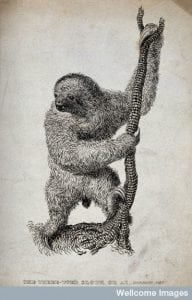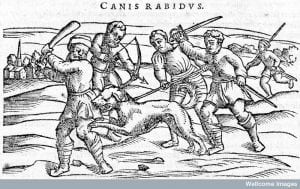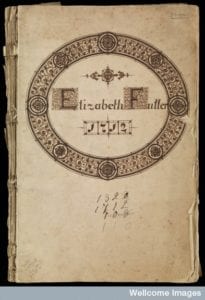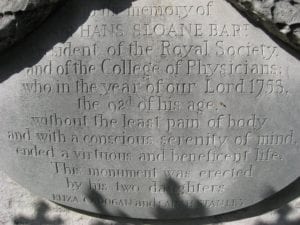
A very old man, suffering from senility. Colour stipple engraving by W. Bromley, 1799, after T. Stothard. Image credit: Wellcome Library, London.
Another day, another governmental exhortation that families just aren’t doing enough to keep society going… This time, it is Simon Hughes (the UK coalition’s justice minister) who suggested that British people had lost a sense of duty to care and were neglecting the elderly. Caregivers regularly bear the brunt of governmental disparagement, especially at a time when an ageing population puts increasing stress on limited resources. The solution, Hughes proposes, is that we look to immigrant cultures who understand the necessity of sacrifice for the good of elderly family members.
Gee, that’ll do the trick… (There’s a thorough dissection of Hughes’ statements over at (Dementia Just Ain’t) Sexy.) But what I want to discuss here is the problematic view of the past underpinning Hughes’ assertions. He ignores the daily experience of modern caregivers and instead assumes that British family responsibility was much more important back in the halcyon olden days.
Let me introduce you to the Meure family in the early eighteenth century, whose case suggests the high costs of caregiving at a time when there were no other options. The Meures were naturalized Huguenot immigrants who had moved to London shortly after Louix XIV had revoked the Edict of Nantes in France. The family’s immigrant status is worth noting, given that the myth of dutiful families relies on the belief that they remained in one place.

The location of the French Academy, where a different sort of dancing now takes place. Image source: my own photograph.
Abraham Meure (senior, hereafter “Meure”) established a boarding school for French Protestants in Soho, but the school—which taught fencing, dancing, drawing and languages—quickly attracted of the English nobility. Times must have been good for the family, as Abraham Meure (junior, hereafter “Abraham”) styled himself as “Gent.” when he married Elizabeth Newdigate in 1707.
Somewhere around 1708, Meure’s son-in-law Moses Pujolas wrote to Hans Sloane. Sloane had previously acted as a legal witness on behalf of Meure who suffered from dementia and senility. The father’s need for care was not disputed within the family; rather, this was a matter of ensuring that Abraham could take over his father’s interests. Unsatisfied with the facts of the case, the jury at the Court of Chancery wanted Meure to attend court. Moses worried that ‘he isn’t in a fit state to conduct himself without embarrassment’ and hoped that Sloane would attest to treating Meure’s senility over time.[1] The family appears to have been protecting Meure by preserving his dignity. The Court treated the debility as temporary, but then removing Meure’s power irrevocably wasn’t the family’s goal, either. The Meures delayed three more years before seeking a permanent ruling.
Meure’s last will dates from 1703 and was proven in 1716.[2] Although it’s hard to know when exactly Meure’s dementia began, the will makes it clear that his daughter Magdalene Pujolas and her family were living with him. According to the will, Abraham received the bulk of his father’s estate, but was to pay Moses £500 as specified in the marriage articles and, within six months of Meure’s death, Magdalene would receive a further £500. Meure declared:
Further, I give my daughter Magdalen Pujolas her board for all the time she lived with me since her marriage, and for three months after my decease, as alsoe the Board of her Husband Moses Pujolas his Children, and servants, and I doe prohibite my Eldest son or his Executors ever to make any demand thereon upon any amount whatever.
In addition, Moses could take back everything in his two furnished chambers and any Pujolas possessions elsewhere in the household. There were bequests to other family members: Robert Pujolas (Magdalene’s son), £500; Andrew Meure (son), £450; and Magdalin Meure (Andrew’s daughter), £100. The particularly generous bequests to the Pujolas family hints that Meure expected them to remain with him indefinitely and that they may already have been providing him with domestic assistance. The Meure family was not wealthy, although the school provided a sufficiently comfortable living to remunerate the Pujolas family for their long-term assistance.
The evidence is, admittedly, patchy. No family records or other letters to Sloane refer to Meure’s deteriorating state, though Moses’ reference to Meure’s likely embarrassment in court suggests that he was in a bad state a mere five years after writing the will. It must have been agonizing for those closest to him who continued to care for him until his death circa 1714, which was when Abraham took over as ratepayer for the property.
Moses and Abraham for many years had a friendly relationship. For example, Moses was Abraham’s guarantor in his marriage settlement of 1707. Not long after Meure died, there were growing tensions within the family. And it is these letters that suggest what the real cost of long-term caregiving was for Magdalene.
In 1719, Abraham wrote to Sloane to question Moses’ treatment of his sister:
I beg the favour of you to lett me know when you saw my sister Pujolas last, and how you found her, her husband saith that he locked her up by your advice.
Sloane replied that he had not treated Mrs Pujolas for several years, but had looked into the matter for Abraham. Magdalene had, apparently, ruined her health, by ‘coveting and drinking large quantities of hott liquors’.
The case must have been severe. Sloane was concerned enough to advise Moses to consult a lawyer about locking Magdalene up in order to limit the quantities of alcohol that she consumed.
Coincidence?
[1] British Library, Sloane MS 4060, ff. 142-3. Pujolas thanked Sloane for an affidavit in BL MS 4060, f. 141,
[2] London Metropolitan Archives, PROB 11: Will Registers – 1713-1722 – piece 554: Fox, Quire Numbers 173-208 (1716), Will of Abraham Meure.







![A woman is carrying a tray with a cup of chocolate [or maybe the pleurisy remedy?] and a glass on it. Credit: Wellcome Library, London.](http://sloaneletters.com/wp-content/uploads/2014/01/Cup-of-chocolate-221x300.jpg)


